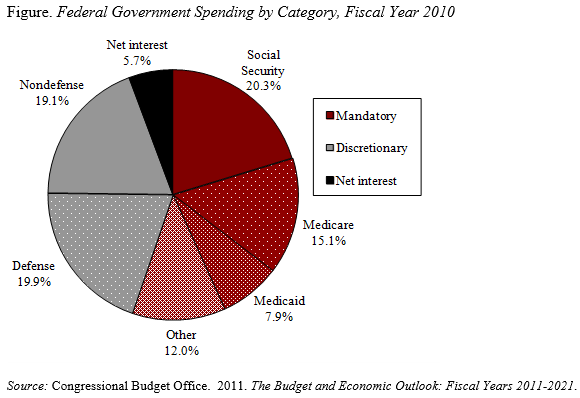
Do We Really Spend a Lot of Money on Poor People?
Alicia H. Munnell is a columnist for MarketWatch and senior advisor of the Center for Retirement Research at Boston College.
David Brooks is one of my favorite commentators. That said, as part of a recent piece – “Midlife Economics” (New York Times 12-26-11) – he wrote that the United States “spends so much on poverty programs that if we just took that money and handed poor people checks, we would virtually eliminate poverty overnight.” The statement was part of the broader argument that analogies between the current period and the progressive era are ill conceived. In the progressive era, the country was young and vibrant, and the job was to impose order. Today, the country is middle aged and self indulgent. The general argument may be right, but the notion that we spend so much money on poor people didn’t ring true.
One useful place to look is the federal budget. Federal government spending falls into three broad categories (see Figure). The first is mandatory programs, such as Social Security, Medicare, Medicaid, and other programs, where spending is determined by rules for eligibility, benefit formulas, and other parameters rather than by specific appropriations. The second category is discretionary spending, which is controlled by annual appropriations. Roughly half of discretionary spending consists of spending on defense and the other half on non-defense programs, such as education, transportation, and agriculture. The final category is interest payments on the nation’s debt.

So where is spending on the poor in this picture? In my view, Social Security and Medicare are not designed for poor people; these programs provide the backbone of the fragile retirement system for all Americans. Most of Medicaid spending does not go to the poor (much goes to middle-income individuals who spend down to qualify for long-term care and to the disabled), and, in any case, it hardly represents money in their pocket. The bulk of non-health spending on the poor is found in the small wedge entitled “other programs” of mandatory spending. This category includes Supplemental Security Income, tax credits (about a third of which might go to the poor), and a handful of other programs. Non-defense discretionary spending also includes a category called “Income Security,” which consists of housing and nutritional assistance. In 2010, federal expenditures on programs for poor people totaled $270 billion, roughly 8 percent of the total federal outlays of $3.456 trillion.
So would handing out checks to poor people virtually eliminate poverty over night? Part of the expenditures, such as Supplemental Security Income, is already included in the income measure for determining poverty, so the payments would be about $195 billion. The Census reports that 46.2 million fell below the poverty threshold in 2010. Each poor person would receive a check of about $4,200. That money would help, but it would not dramatically change the poverty picture in this country.







